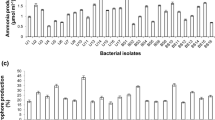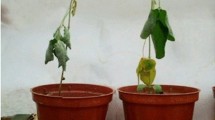Abstract
Corms serve as the primary mode of reproduction for saffron, which growth state determines the yield and quality of saffron under field cultivation conditions. In this study, fourteen rhizobacteria were isolated from the rhizosphere soil of C. sativus. The findings of this study indicate that all of the rhizobacterial isolates have the capacity to synthesize indole-3-acetic acid and gibberellic acid. Among the 14 rhizobacterial isolates, four isolates exhibited the capability to solubilize phosphate, six isolates showed nitrogen fixation ability, and four isolates were identified as effective producers of siderophore. Only one isolate exhibited the capability to degrade 1-aminocyclopropane-1-carboxylate. As indicated by the findings from the field trials, it was observed that SR144 (Paenibacillus silvae), SR163 (Bacillus idriensis), SR269 (Pseudomonas sp.), SR307 (Stenotrophomonas sp.), and SR383 (Stenotrophomonas maltophilia) had a positive impact on the fresh weight of corms and leaf length of C. sativus. Additionally, a reduction in the malondialdehyde content was observed, accompanied by an elevation in the antioxidant enzyme system in corms. Further research indicates that SR307 and SR383 cause an increase in the total bacterial count, resulting in elevated levels of microbial biomass carbon and nitrogen in rhizosphere soil, and the levels of soil sucrase, urease, dehydrogenase, catalase, and alkaline phosphatase activities were also increased. Only SR383 exhibits an increase in acid phosphatase activity. Finally, the correlation analysis showed that the positive effects caused by beneficial rhizobacteria were important for the increase of corms production.






Similar content being viewed by others
References
Ambardar S, Vakhlu J (2013) Plant growth promoting bacteria from Crocus sativus rhizosphere. World J Microbiol Biotechnol 29(12):2271–2279. https://doi.org/10.1007/s11274-013-1393-2
Avila-Sosa R, Nevarez-Moorillon GV, Ochoa-Velasco CE, Navarro-Cruz AR, Hernandez-Carranza P, Cid-Perez TS (2022) Detection of saffron’s main bioactive compounds and their relationship with commercial quality. Foods 11(20):3245. https://doi.org/10.3390/foods11203245
Bukhari SI, Manzoor M, Dhar MK (2018) A comprehensive review of the pharmacological potential of Crocus sativus and its bioactive apocarotenoids. Biomed Pharmacother 98:733–745. https://doi.org/10.1016/j.biopha.2017.12.090
Dinesh R, Anandaraj M, Kumar A, Bini YK, Subila KP, Aravind R (2015) Isolation, characterization, and evaluation of multi-trait plant growth promoting rhizobacteria for their growth promoting and disease suppressing effects on ginger. Microbiol Res 173:34–43. https://doi.org/10.1016/j.micres.2015.01.014
Douglas MH, Smallfield BM, Wallace AR, McGimpsey JA (2014) Saffron (Crocus sativus L.): The effect of mother corm size on progeny multiplication, flower and stigma production. Sci Hortic 166:50–58. https://doi.org/10.1016/j.scienta.2013.12.007
Ezrari S, Mhidra O, Radouane N, Tahiri A, Polizzi G, Lazraq A et al (2021) Potential role of rhizobacteria isolated from citrus rhizosphere for biological control of citrus dry root rot. Plants (basel) 10(5):872. https://doi.org/10.3390/plants10050872
Finkel OM, Castrillo G, Paredes SH, Gonzalez IS, Dangl JL (2017) Understanding and exploiting plant beneficial microbes. Curr Opin Plant Biol 38:155–163. https://doi.org/10.1016/j.pbi.2017.04.018
Flores-Felix JD, Menendez E, Marcos-Garcia M, Mateos PF, Martinez-Molina E, Velazquez ME et al (2016) PGPR-based biofertilizers increase carrot production. New Biotechnol 33(3):430–431. https://doi.org/10.1016/j.nbt.2015.10.047
Foyer CH, Rasool B, Davey JW, Hancock RD (2016) Cross-tolerance to biotic and abiotic stresses in plants: a focus on resistance to aphid infestation. J Exp Bot 67(7):2025–2037. https://doi.org/10.1093/jxb/erw079
Gul F, Khan IU, Rutherford S, Dai ZC, Li G, Du DL (2023) Plant growth promoting rhizobacteria and biochar production from Parthenium hysterophorus enhance seed germination and productivity in barley under drought stress. Front Plant Sci 8(14):1175097. https://doi.org/10.3389/fpls.2023.1175097
Gupta S, Pandey S, Kotra V, Kumar A (2023) Assessing the role of ACC deaminase-producing bacteria in alleviating salinity stress and enhancing zinc uptake in plants by altering the root architecture of French bean (Phaseolus vulgaris) plants. Planta. https://doi.org/10.1007/s00425-023-04159-3
Gu XB, Cai HJ, Du YD, Li YN (2019) Effects of film mulching and nitrogen fertilization on rhizosphere soil environment, root growth and nutrient uptake of winter oilseed rape in northwest China. Soil Tillage Res 187:194–203. https://doi.org/10.1016/j.still.2018.12.009
Khan A, Bano A, Khan RA, Khan N (2023) Role of PGPR in suppressing the growth of Macrophomina phaseolina by regulating antioxidant enzymes and secondary metabolites in Vigna radiata L. Wilczek South African J Bot 158:443–451. https://doi.org/10.1016/j.sajb.2023.05.040
Kour R, Ambardar S, Vakhlu J (2018) Plant growth promoting bacteria associated with corm of Crocus sativus during three growth stages. Lett Appl Microbiol 67(5):458–464. https://doi.org/10.1111/lam.13042
Liu DF, Sun HJ, Ma HW (2019) Deciphering microbiome related to rusty roots of panax ginseng and evaluation of antagonists against pathogenic ilyonectria. Front Microbiol 18(10):1350. https://doi.org/10.3389/fmicb.2019.01350
Maillet F, Fournier J, Mendis HC, Tadege M, Wen J, Ratet P, Mysore KS, Gough C, Jones KM (2020) Sinorhizobium meliloti succinylated high-molecular-weight succinoglycan and the Medicago truncatula LysM receptor-like kinase MtLYK10 participate independently in symbiotic infection. Plant J 102(2):311–326. https://doi.org/10.1111/tpj.14625
Liu S, Wang ZY, Niu JF, Dang KK, Zhang SK, Wang SQ et al (2021) Changes in physicochemical properties, enzymatic activities, and the microbial community of soil significantly influence the continuous cropping of Panax quinquefolius L. (American ginseng). Plant and Soil 463(1–2):427–446. https://doi.org/10.1007/s11104-021-04911-2
Liu ZP, Zhang XL, Li LB, Xu N, Hu Y, Wang C et al (2022) Isolation and characterization of three plant growth-promoting rhizobacteria for growth enhancement of rice seedling. J Plant Growth Regul 41(3):1382–1393. https://doi.org/10.1007/s00344-021-10393-4
Magotra S, Bhagat N, Ambardar S, Ali T, Hurek BR, Hurek T, Verma PK, Vakhlu J (2021) Field evaluation of PGP Bacillus sp. strain D5 native to Crocus sativus in traditional and non traditional areas and mining of PGP genes from its genome. Sci Rep 11(1):5454. https://doi.org/10.1038/s41598-021-84585-z
Mao TT, Jiang XL (2021) Changes in microbial community and enzyme activity in soil under continuous pepper cropping in response to Trichoderma hamatum MHT1134 application. Sci Rep 11(1):21585. https://doi.org/10.1038/s41598-021-00951-x
Mir MA, John R, Alyemeni MN, Alam P, Ahmad P (2018) Jasmonic acid ameliorates alkaline stress by improving growth performance, ascorbate glutathione cycle and glyoxylase system in maize seedlings. Sci Rep 8(1):2831. https://doi.org/10.1038/s41598-018-21097-3
Nivelle E, Verzeaux J, Chabot A, Roger D, Chesnais Q, Ameline A et al (2018) Effects of glyphosate application and nitrogen fertilization on the soil and the consequences on aboveground and belowground interactions. Geoderma 311:45–57. https://doi.org/10.1016/j.geoderma.2017.10.002
Pallavi Mishra RK, Sahu PK, Mishra V, Jamal H, Varma A et al (2023) Isolation and characterization of halotolerant plant growth promoting rhizobacteria from mangrove region of Sundarbans, India for enhanced crop productivity. Front Plant Sci 14:1122347. https://doi.org/10.3389/fpls.2023.1122347
Passeri V, Koes R, Quattrocchio FM (2016) New challenges for the design of high value plant products: stabilization of anthocyanins in plant vacuoles. Front Plant Sci 7:153. https://doi.org/10.3389/fpls.2016.00153
Perez-Flores P, Valencia-Cantero E, Altamirano-Hernandez J, Pelagio-Flores R, Lopez-Bucio J, Garcia-Juarez P et al (2017) Bacillus methylotrophicus M4–96 isolated from maize (Zea mays) rhizoplane increases growth and auxin content in Arabidopsis thaliana via emission of volatiles. Protoplasma 254(6):2201–2213. https://doi.org/10.1007/s00709-017-1109-9
Ramegowda V, Senthil-Kumar M (2015) The interactive effects of simultaneous biotic and abiotic stresses on plants: Mechanistic understanding from drought and pathogen combination. J Plant Physiol 176:47–54. https://doi.org/10.1016/j.jplph.2014.11.008
Shabaan M, Asghar HN, Zahir ZA, Zhang X, Sardar MF, Li HN (2022) Salt-tolerant PGPR confer salt tolerance to maize through enhanced soil biological health, enzymatic activities, nutrient uptake and antioxidant defense. Front Microbiol 13:901865. https://doi.org/10.3389/fmicb.2022.901865
Shi Z, Yang Y, Fan Y, He Y, Li T (2023) Dynamic responses of rhizosphere microorganisms to biogas slurry combined with chemical fertilizer application during the whole life cycle of rice growth. Microorganisms 11(7):1755. https://doi.org/10.3390/microorganisms11071755
van Wyk DAB, Adeleke R, Rhode OHJ, Bezuidenhout CC, Mienie C (2017) Ecological guild and enzyme activities of rhizosphere soil microbial communities associated with Bt-maize cultivation under field conditions in North West Province of South Africa. J Basic Microbiol 57(9):781–792. https://doi.org/10.1002/jobm.201700043
Wang G, Li BW, Peng DL, Zhao HZ, Lu MY, Zhang LS et al (2022) Combined application of H2S and a plant growth promoting strain JIL321 regulates photosynthetic efficacy, soil enzyme activity and growth-promotion in rice under salt stress. Microbiol Res 256:126943. https://doi.org/10.1016/j.micres.2021.126943
Wang YJ, Wu YX, Cao CY, Han S, Zhao WS, Li QS et al (2023) Effects of fertilizer reduction coupled with straw returning on soil fertility, wheat root endophytic bacteria, and the occurrence of wheat crown rot. Front Microbiol 14:1143480. https://doi.org/10.3389/fmicb.2023.1143480
Wu J, Joergensen RG, Pommerening B, Chaussod R, Brookes PC (1990) Measurement of soil microbial biomass c by fumigation-extraction—an automated procedure. Soil Biol Biochem 22(8):1167–1169. https://doi.org/10.1016/0038-0717(90)90046-3
Wu LN, Jiang Y, Zhao FY, He XF, Liu HF, Yu K (2020) Increased organic fertilizer application and reduced chemical fertilizer application affect the soil properties and bacterial communities of grape rhizosphere soil. Sci Rep 10(1):9568. https://doi.org/10.1038/s41598-020-66648-9
Xu H, Shao H, Lu Y (2019) Arbuscular mycorrhiza fungi and related soil microbial activity drive carbon mineralization in the maize rhizosphere. Ecotoxicol Environ Saf 30(182):109476. https://doi.org/10.1016/j.ecoenv.2019.109476
Zhang K, Adams JM, Shi Y, Yang T, Sun R, He D et al (2017) Environment and geographic distance differ in relative importance for determining fungal community of rhizosphere and bulk soil. Environ Microbiol 19(9):3649–3659. https://doi.org/10.1111/1462-2920.13865
Zhang ZF, Fu Q, Xiao CYX, Ding MY, Liang D, Li HT et al (2022) Impact of Paenarthrobacter ureafaciens ZF1 on the soil enzyme activity and microbial community during the bioremediation of atrazine-contaminated soils. BMC Microbiol 22(1):146. https://doi.org/10.1186/s12866-022-02556-4
Acknowledgements
This work was financially supported by the National Natural Science Foundation of China (No. 82174091), the Basic Medical Research Project of Naval Medical University (No. 2022MS004), and Sustainable Development Science and Technology Innovation Action Plan of Shanghai Chongming District (No. CK2021-03).
Author information
Authors and Affiliations
Contributions
TH, L-PQ, and BZ conceived and designed the research; JCX and XGX performed the research, and wrote manuscript; KR revised manuscript; XWB, JHZ, and ZHZ performed part of the experiments; JCX and ZHZ analyzed the data; all authors have read and approved the final manuscript. JCX and XGX contributed equally to this work and share first authorship.
Corresponding authors
Ethics declarations
Conflict of interest
The authors declare that they have no conflict of interest.
Additional information
Handling Editor: Fabricio José Pereira.
Publisher's Note
Springer Nature remains neutral with regard to jurisdictional claims in published maps and institutional affiliations.
Rights and permissions
Springer Nature or its licensor (e.g. a society or other partner) holds exclusive rights to this article under a publishing agreement with the author(s) or other rightsholder(s); author self-archiving of the accepted manuscript version of this article is solely governed by the terms of such publishing agreement and applicable law.
About this article
Cite this article
Xu, JC., Xie, XG., Bi, XW. et al. Isolation of Rhizobacteria from Crocus Sativus L. Rhizosphere and Their Effects on Host-Growth Promotion. J Plant Growth Regul 43, 1536–1547 (2024). https://doi.org/10.1007/s00344-023-11205-7
Received:
Accepted:
Published:
Issue Date:
DOI: https://doi.org/10.1007/s00344-023-11205-7




